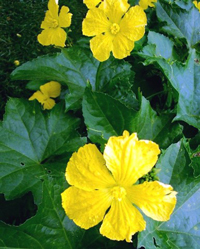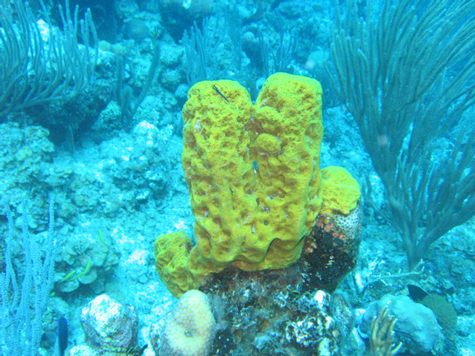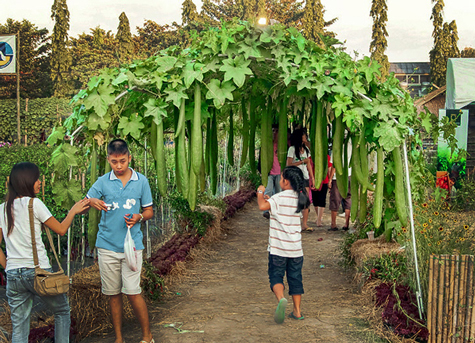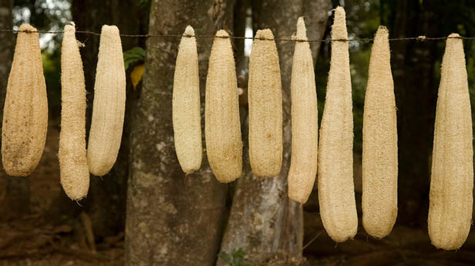Human Flower Project
Luffa: Wring in the New Year
Plant a garden of amazement this year and harvest a kitchen tool.
 The flower of Luffa aegyptiaca
The flower of Luffa aegyptiaca
Photo: Garden Life
By James H. Wandersee and Renee M. Clary
EarthScholars™ Research Group
How about a New Year’s resolution that’s actually an absorbing pleasure? This year, grow some garden plants that fascinate children. We suggest that you begin by rekindling your own sense of wonder: raising a plant that imitates a sea animal.
We all know that sponges are animals that live and grow beneath the sea. Sponge divers retrieve natural sponges for human applications. There are over 5,000 species of sponge animals, freshwater and marine, but only 15 species have fibrous “skeletons” that are absorbent and soft enough for people to use. The divers cut these loose from the sea floor (provided they meet legal size limits), then clean and sun-dry them.
If you want to interact with real sponge-fishers and purchase animal sponges newly harvested from the Gulf of Mexico, we suggest you visit the sponge docks at Tarpon Springs, Florida. This city boasts the US’s highest percentage of Greek-Americans and is, historically, a sponge-fishing community. There you can even go sponge-fishing on a working boat with a professional diver.

Sponge on the floor of the Caribbean Sea
Mike and Debbie Travel Album
But you don’t need to live by the sea to harvest a sponge. (We are using the term sponge in the sense of tool and not organism.) You can grow your own, and use it for bathing and dishwashing.
It’s true. Plant sponges have many common names such as the luffa squash (pronounced loo’-fah) or sponge gourd or climbing okra. Botanically, it’s a tropical vine species: Luffa aegyptiaca Mill.— also known as Luffa cylindrica.
This plant is a member of the Cucurbitaceae or cucurbit family (also commonly referred to as the cucumber, gourd, melon, or pumpkin family). Species-wise, it is a medium-sized plant family primarily found in the warmer regions of both the old and new world.

Children explore a luffa plant “cave-like” trellis system
Photo: B. Inxee, Annie’s Annuals and Perennials
The luffa plant yields 1- to 3-foot–long, zucchini-like fruits (seed pods) which turn from green to yellow when ripe. When the skin, pulp, and seeds are removed, and after the remaining internal fibrous cellulose (xylem) network is sun-dried for several weeks, it is ready to use as a household sponge.
In nature, these cellulosic fibers actually serve to support and disperse the plant’s hundreds of black, flat seeds, but humans have learned that they can use and reuse this network as a sponge, once it is cleaned and dried. Environmentally conscious plant enthusiasts will appreciate that luffa sponges are a natural, biodegradable, and renewable resource.
First, you will need some seeds. Your favorite seed companies may carry these, or you may prefer to search Amazon.com for ‘luffa seeds’ if you wish to peruse a large array offered by many different seed companies.
We think it’s important to know that luffa plants cross-pollinate easily. If you wish to grow luffa plants that maintain “trueness-to-type” year after year, then do not grow different types of luffa seeds (cultigens) within 1,500 feet of each other.
“If you wish to try growing luffas [where the growing season is shorter]…start seeds indoors several weeks before the desired transplant date. Seeds can take up to 2 weeks to sprout. Pre-soaking in warm water for 48 hours will speed germination. Set transplants out as soon as the soil has warmed”—suggests University of Minnesota horticulturist Jill MacKensie. Luffas grow best in hardiness zones 7 and higher.
The challenges and secrets of growing luffa sponges are detailed in words and images tailored for novice growers at this easy-to-understand and colorful web site.
That informative resource was designed by the Blumenstock family of Elizabethton, Tennessee, because, in their words, “growing luffa vines has been a fun and interesting hobby [for us] for many years now.” They also sell their own heirloom luffa seeds. They advise beginners that “luffa requires about 140 to 200 or more frost-free days, depending on the location and variety grown. It needs lots of sun, warmth, water, good root nutrients, and a large, strong trellis.”

An amateur gardener’s peeled and deseeded luffa sponges drying on a line
Photo:
“ title=” worchester allotment”>Worchester Allotment
Commercially, luffa sponges that are sold in U.S. stores are typically imported from China, Korea, Taiwan, El Salvador, Guatemala, Columbia, or Venezuela.
Jeanine M. Davis, a North Carolina State University luffa expert, explains why the U.S. is not a leading source, saying: “Presently, one of the most difficult aspects of entering into commercial luffa sponge gourd production is obtaining large volumes of high quality seed. Much of the luffa seed sold for home gardens produces small, low-quality sponges with weak fibers.” Note that the take-home message is this—after you have produced luffa sponges of the quality that you desire, be sure to save the seeds from your best sponges!
Although it is possible to grow up to 20,000 sponges per acre, the crop is labor-intensive because the plants need to be trained on trellises or other supports, may need fungicide and insecticide treatments, and must also be hand-processed to produce saleable sponges.
 Luffa sponge, ready for bathing
Luffa sponge, ready for bathing
Photo: Chemical Engineering
The current economic reality is that a wholesale cost of 10 cents to 40 cents per sponge supports a retail price of $5. At today’s consumer demand levels, high quality, imported luffa sponges are both plentiful and inexpensive. Small-scale U.S. growers are mainly found in the southeastern U.S. and they use luffas as a supplemental crop. An increase in the number of environmentally conscious U.S. consumers and/or its household applications could lead to a ramping-up of U.S. luffa production.
Why not accept the challenge of growing your own plant sponges and share this gardening project with a child? Children may remember such curious plant projects all their lives and follow a path of life-long appreciation of the wonders of plants. You can become a change agent—while having fun watching these amazing plants grow and teaching children about plant life. Resolve to become someone’s plant mentor in 2012!
Comments
This gardening project idea is brilliant but unfortunately for me, I do not have the right growing conditions.
I wonder if I can find the gourd locally as K.N.‘s recipe for bhajjis reads deliciously!


Great write-up!
I grew one plant last year and we had so many fruits that I had to give them to interested people in my neighbourhood and few of them I have dried and converted to sponge. I got hundred of seed and I have now started a new set of plants for growing this year.
You can see a few pictures on my blog
http://xploreandxpress.blogspot.com/2011/06/organic-gardening-sponge-gourd.html